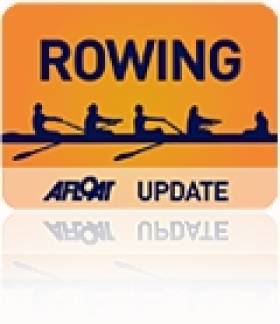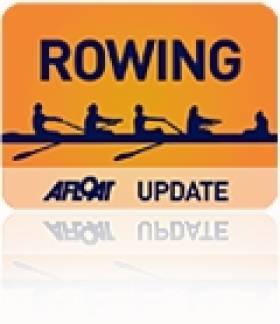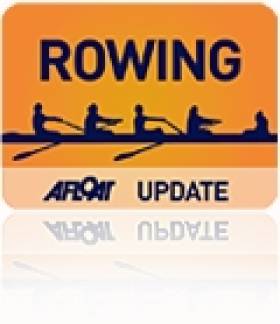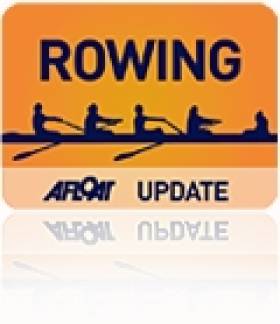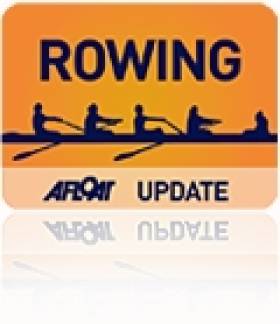Displaying items by tag: Puspure
Lightweight Rowers Top Rankings at Ireland Trial
#ROWING: Irish rowing grabbed a few hours of relative calm between spells of gusting wind to stage the second session of the Ireland Trial at Newry Canal today. Lightweight single sculler Siobhán McCrohan (26) again topped the overall rankings – bettering her per centage of projected world gold medal winning time set on Saturday.
Paul O’Donovan and Sanita Puspure also confirmed their good form, with O’Donovan teaming up to good effect with Shane O’Driscoll in a lightweight double scull. One of the most encouraging aspects of the weekend was the evidence of a breadth of talent in the lightweight men’s category – Anthony English did well today, and Niall Kenny was not far behind.
Ireland Trial, Newry Canal (Run over 5km; Selected Results)
(Percentage is of projected world gold medal winning time)
Saturday
Men
Pair – Senior: 1 D Neale, C Folan 18 minutes 41.53 seconds (82.03), 2 D Power, P O’Connell 18:53.62 (81.6). Under-23: 1 R O’Callaghan, R Bennett 18:29.53 (82.92), 2 M Pukelis, K Neville 19:23.43 (79.08). Junior: D Keohane, B Keohane 19:06.58 (80.24), 2 Murphy, O’Connell 19:26.23 (78.89), 3 Fallon, Bennett 19:32.47 (78.47).
Lightweight: 1 Quinlan, O’Connor 19:27.59 (81.36), 2 McKenna, Murphy 19:30.72 (81.15), 3 Keane, Breen 19:32.55 (81.02).
Sculling,
Single – Senior: 1 J Keohane 19:16.47 (84.31), 2 A McEvoy 19:37.34 (82.81). Under-23: 1 T Oliver 19.47.82 (82.08), 2 A Harrington 19:52.47 (81.76), 3 S McKeown 20:06.03 (80.84). Junior: 1 D O’Malley 19:41.55 (82.5), 2 C Carmody 19:57.29 (81.43), 3 C Hennessy 20:15.6 (80.21).
Lightweight – Senior: 1 N Kenny 19:18.40 (86.33), 2 J Ryan 19:28.13 (85.61), 3 M O’Donovan 19:30.07 (85.46). Under-23: P O’Donovan 19:05.46 (87.3), 2 S O’Driscoll 19:26.18 (85.75), 3 C Beck 19:41.35 (84.65).
Women
Four – Senior: Deasy, McCarthy, O’Brien, Leahy 19:51.76 (84.33).
Pair – Senior: L Dileen, A Keogh 20:12.32 (84.14), 2 Bennett, Gilligan 21:28.79 (79.14). Under-23: G Collins, O Finnegan 21.05.13 (80.62). Junior: 1 K O’Connor, H Hickey 21:43.08 (78.28), 2 Clarke, Glover 21:54.75 (77.58), 3 Nagle, O’Keeffe 22:33.06 (75.38).
Sculling
Single – Senior: 1 S Puspure 20:21.36 (86.99), 2 M Dukarska 2:40.57 (85.65), 3 E Moran 21:20.92. Under-23: 1 C Fitzgerald 21.50.12 (81.10), 2 H O’Sullivan 22:14.21 (79.64), 3 M Dineen 22:27.69 (78.84). Junior: 1 E Lambe 21:47.62 (81.25), 2 J English 21:54.17 (80.85), 3 E Barry 22:03.17 (80.30).
Lightweight – Senior: 1 S McCrohan 20:58.15 (87.43), 2 C Jennings 21:15.24 (86.26), 3 O Hayes 21:18.60 (86.03). Under-23: 1 R Morris 21:32.68 (85.09), 2 S Horgan 21:47.18 (84.15).
Sunday
(Provisional Results)
Overall (ranked on per centage of projected world gold medal time): 1 S McCrohan (lightweight senior single scull) 2o:50.49 (87.97), 2 P O’Donovan, S O’Driscoll (lightweight under-23 double) 17:26.91 (87.40), 3 S Puspure (women’s senior single) 20:17.63 (87.26), 4 A English (lightweight senior single) 19:13.24 (86.71), 5 M Dukarska, E Moran (women’s senior double) 19:02.81 (86.63), 6 N Kenny (lightweight single) 19:18.26 (86.34).
Men
Pair, Senior: 1 Coughlan, Buckley 19:02.79 (80:50), 2 Neale, Folan 19:08.71 (80.09). Under-23: 1 O’Callaghan, Bennett 18:34.83 (82.52), 2 Power, O’Connell 18:44.47 (81.82), 3 M Pukelis, K Neville 19:13.78 (79.74). Junior: 1 Keohane, Keohane 19:04.69 (80:37), 2 Fallon, Bennett 19:20.32 (79.29), 3 Murphy, O’Connell 19:21.50 (79.21).
Lightweight, Senior: 1 Prendergast, O’Donovan 18:35.31 (85.18), 2 Ryan, Griffin 18:38.23 (84.96), 3 McKenna, Murphy 19:05.94 (82.90). Under-23: 1 Hegarty, Ryan 19:24.87 (81.55), 2 Keane, Breen 19:25.40 (81.52).
Sculling, Double – Under-23: 1 T Oliver, C Beck 18:06.94 (82.57).
Lightweight, Under-23: O’Donovan, O’Driscoll 17.26.91 (87.40)
Single – Senior: 1 Keohane 19:05.78 (85.09), 2 A McEvoy 19:27.84 (83.49), 3 A Bolger 20:52.45 (77.85). Under-23: 1 A Harrington 19:29.92 (83.34), 2 S McKeown 20:03.43 (81.02), 3 A Boreham 20:57.27 (77.55). Junior: 1 O’Malley 19:29.80 (83.35), 2 Carmody 19:55.68 (81.54), 3 A Gough 20:12.44 (80.42).
Lightweight, Senior: 1 A English 19:30.24 (86.71), 2 N Kenny 19:18.26 (86.34). Under-23: 1 D Quinlan 19:54.86 (83.69), 2 S O’Connor 20:05.94 (82.92)
Women
Pair – Senior: 1 Dilleen, Keogh 20:00.78 (84.94), 2 M O’Neill, E Tormey 20:30.55 (82.89). Under-23: Fitzgerald, Dinneen 21:33.47 (78.86). Junior: 1 O’Connor, Hickey 21:36.52 (78.67), 2 Wray, Morelli 21:41.98 (78.34), 3 Clarke, Glover 22.11.23 (76.62).
Double – Senior: Dukarska, E Moran 19:02.81 (86.63)
Sculling, Single – Senior: Puspure 20:17.63 (87.26). Under-23: 1 H O’Sullivan 22:16.18 (79.52), 2 B Walsh 22:35.91 (78.36)
Junior: 1 J English 21:23.36 (82.79), 2 E Lambe 21:27.12 (82.55), 3 E Hegarty 21:37.89 (81.86).
Lightweight – Senior: 1 McCrohan 20:50.49 (87.97), 2 O Hayes 21:14.15 (86.33), 3 C Jennings 21:19.10 (86.00). Under-23: 1 R Morris 21:37.26 (84.79), 2 S Horgan 22:10.68 (82.66)
Fine Start by Ireland at European Rowing Championships
# ROWING: Ireland had a good start at the European Rowing Championships in Seville today. Claire Lambe nailed the second place she needed to qualify directly for the A Final of the lightweight single sculls and Sanita Puspure qualified for her semi-final of the single sculls by taking the third of three qualification places.
Ireland’s two other crews face into repechages later today. Niall Kenny and Justin Ryan took third in a heat of the lightweight double sculls won by Italy, who took the one semi-final place on offer, repelling a challenge by Austria. Ireland won a mini-battle with Bulgaria for third.
John Keohane finished fifth in his heat of the single sculls. Germany’s Marcel Hacker had his expected win, with Mindaugas Griskonis of Lithuania taking the second qualification place. Keohane, who is new to this level, held off Russian Denis Kleshnev, who finished sixth.
European Rowing Championships, Seville – Day One (Irish interest)
Men
Lightweight Double Sculls – Heat Four (One Directly to A/B Semi-Finals; rest to Repechages): 1 Italy (A Micheletti, P Ruta) 6:39.92; 2 Austria 6:44.49, 3 Ireland (N Kenny, J Ryan) 6:47.43, 4 Bulgaria 6:48.89, 5 Czech Republic 6:51.76.
Single Sculls – Heat One (First Two Directly to A/B Semi-Finals; rest to Repechages): 1 Germany (M Hacker) 7:03.91, 2 Lithuania (M Griskonis) 7:08.15; 3 Italy 7:19.44, 4 Greece 7:22.19, 5 Ireland (J Keohane) 7:25.67, 6 Russia 7:27.89.
Women
Single Sculls – Heat One (First Three to A/B Semi-Finals; rest to Repechage): 1 Ukraine (N Dovgodko) 8:04.02, 2 Norway (T Gjoertz) 8:04.65, 3 Ireland (S Puspure) 8:09.24; 4 Bulgaria 8:18.54, 5 Armenia 9:41.08.
Lightweight Single Sculls – Heat One (First Two Directly to A/B Semi-Finals; rest to Repechage): 1 Austria (M Tauper-Traer) 7:25.35, 2 Ireland (C Lambe) 7:58.09; 3 Czech Republic 8:06.09, 4 France 8:09.57, 6 Cyprus 8:10.61.
Ireland Olympian Puspure is Afloat Rower of the Year
# ROWING: Sanita Puspure is the Afloat Rower of the Year for 2012. Puspure made the A Final as a single sculler at World Cup Regattas in Belgrade and Munich and did wonderfully well to qualify as the sole Ireland rowing representative at the Olympic Games. In the Olympic Qualification Regatta at Lucerne she claimed the fourth and final place, pushing Iva Obradovic of Serbia, one of the favourites, into fifth. The three women who finished ahead of Puspure cut a dash at London 2012: Denmark’s Fie Udby Erichsen took silver; Kim Crow of Australia took bronze (in addition to a silver in the double sculls); America’s Genevra Stone won the B Final. Puspure’s position was destined to be in the 11 to 13 ranking and she was unlucky first to suffer illness in the run up to the Games and then to be drawn in a difficult quarter-final which saw her lose out narrowly on a place in the A/B Semi-Finals, the top 12. She won the C Final convincingly to place 13th. After the race she spoke of looking forward to climbing the rankings in this discipline and of targeting Rio 2016. Her steeliness in key races and her very good form in the recent National Assessment suggests that the 30-year-old could be a rower to watch in this Olympiad.
Rower of the Year: The judging panel is made up of Liam Gorman, rowing correspondent of The Irish Times and David O'Brien, Editor of Afloat magazine.
Rowing Round–up: Puspure Fifth in Belgrade, Keohane Wins in Ghent, Black and Cassells in the Hunt
#ROWING – After an intense weekend of international competition for Irish rowers Sanita Puspure finished fifth in the A Final of the single scull at the World Cup Regatta in Belgrade. Puspure tasted this level of competition in the single scull for the first time. Claire Lambe finished fifth in the A Final of the lightweight single sculls at the World Cup.
John Keohane Won the Men's Single Scull at Ghent Rowing Regatta but he was only one of a collection of Irish winners.
Chris Black and Joel Cassells did themselves no harm in the hunt for selection on the Ireland team for the World Junior Championships when they won their final at Munich Junior Regatta.
All the latest Irish rowing news here
Dilleen and Puspure Hit by Poor Start in Lucerne
Ireland’s women’s double of Lisa Dilleen and Sanita Puspure have had to settle for a place in the B Final at the World Cup rowing championships in Lucerne. In their semi-final they missed strokes after catching a buoy near the start and were never contenders for one of the top three places which would have sent them into the A Final.
World Cup Regatta, Lucerne – Day Two (Irish interest)
Men
Lightweight Double Scull – D Final (places 19 to 24): 1 Hungary 6:36.15, 2 Ireland 6:43.77, 3 Sweden 6:44.75.
Women
Double Scull – Semi-Final (First Three to A Final; rest to B Final): 1 Australia 6:54.22, 2 Ukraine 6:56.73, 3 Poland 6:58.30; 4 Belarus 7:07.73, 5 Romania 7:09.95, 6 Ireland (L Dilleen, S Puspure) 7:15.75
Lightweight Double Scull – C Final (Places 13 to 18): 1 Austria 7:14.01; 5 Ireland (S Dolan, C Lambe) 7:19.47
Lightweight Single Scull – Semi-Final One (First Three to A Final; rest to B Final): 1 Switzerland (P Weisshaupt) 7:56.1, 2 Ireland (S McCrohan) 7:58.65, 3 Belgium (J Hammond) 8:03.22; 4 Japan 8:09.31, 5 Canada 8:09.80, 6 Hong Kong 8:14.50.


























